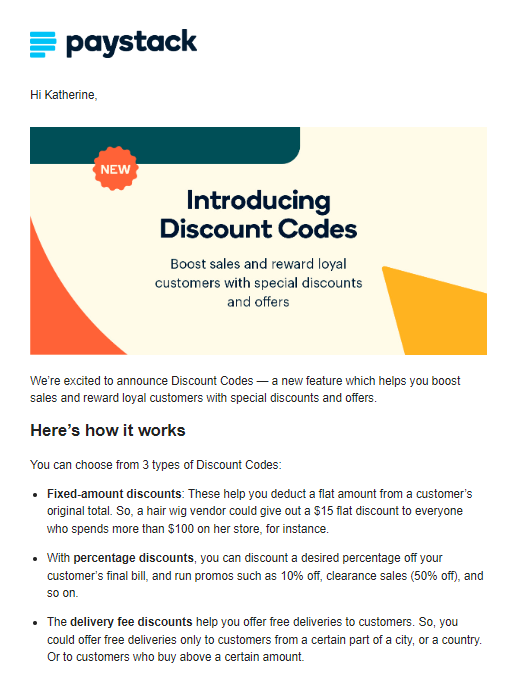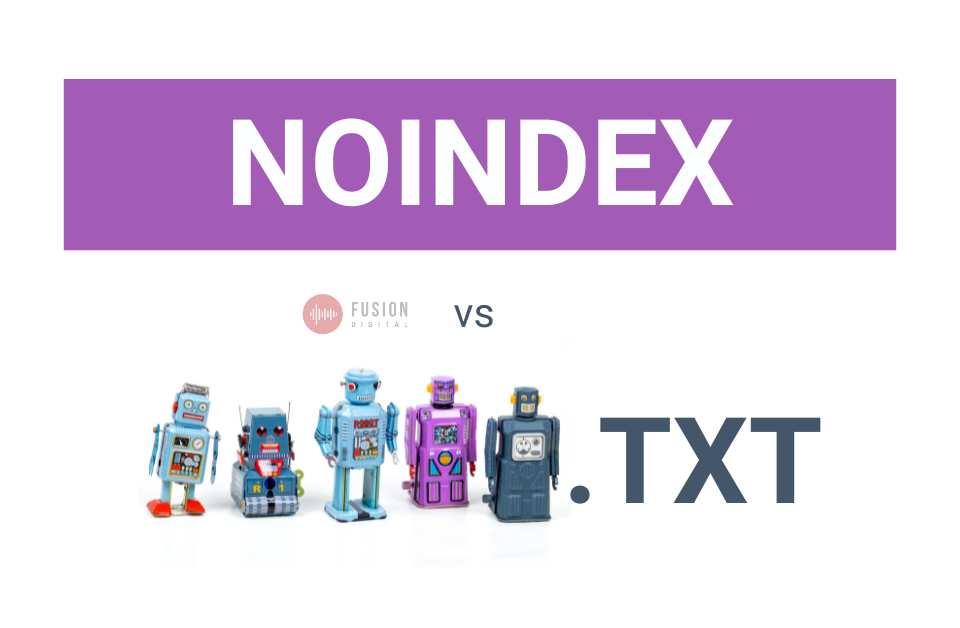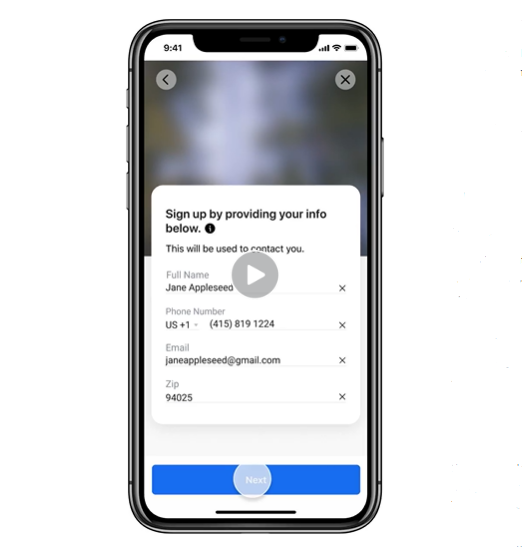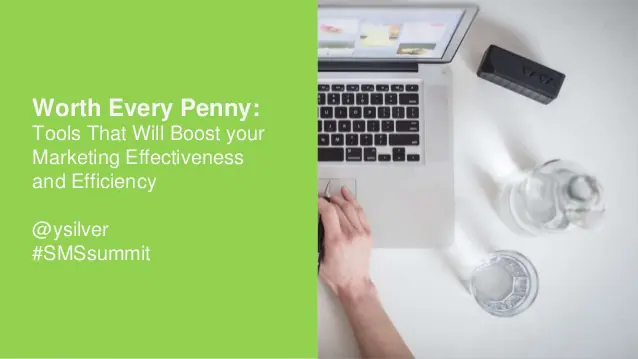
Noindex Vs Robots.txt: Which Should You Use and When?
May 1, 2023So you’ve built a decent amount of subscribers for your email list. That’s great! But now, you’re likely wondering what type of email to send your audience to keep them engaged. Not just emails to engage them, but to also nurture and convert them.
The answer is there are several email content that can help you drive engagement and sales. And in this post, you’ll learn 10 types of emails to send to customers whether you’re running sales, soliciting reviews, or appreciating customers. This isn’t an exhaustive list, but it’s a great start. That said, let’s get into it.
1. Welcome Email
Onboarding and welcome emails are a popular type of email businesses send to customers and rightly so. Why? According to research, welcome emails have an average open rate of 63.91% and a click-through rate of 14.34% — 3x more than regular newsletters. That’s because, at this stage, customers are captivated by your products. They’re excited to engage with your brand, explore your product, and understand how it would improve their lives.
At this stage, build a relationship with the customer. Retain their interest by providing information on the value your products or services offer. Remember, the faster they start using your solutions, the sooner they can enjoy the benefits.
Sitebulb’s welcome mail below captures this opportunity perfectly. The welcome text which doubles as an onboarding email, outlines the first—and likely most important—action users should take. That is confirming their account within 24 hours. Below that section, you’ll find helpful guides that would help the user navigate their product or contact support. The final section, which isn’t visible in the screenshot below, features a list of resources, channels, and what to expect from each.
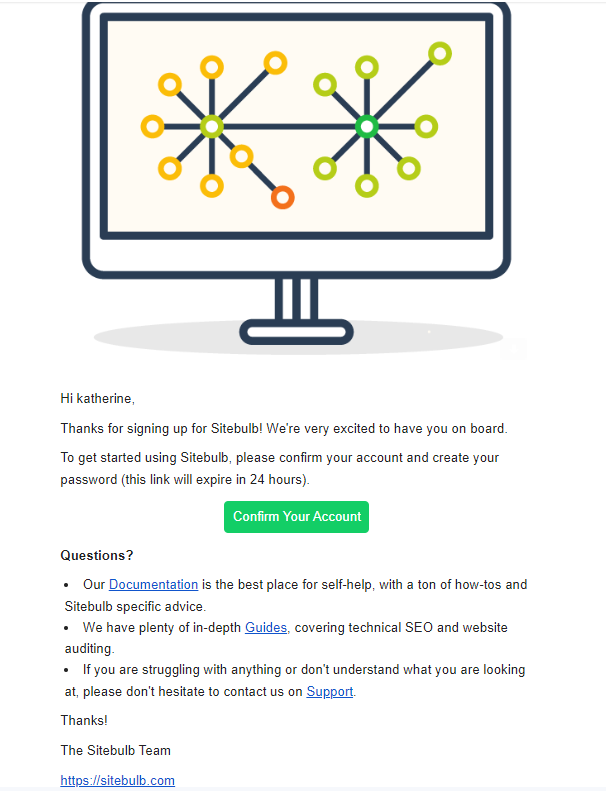
If you acquired a user through a free offer, it’s also important to align your offer delivery email with a warm welcome. That’s an opportunity to retain the attention of the customer beyond that offer.
Here’s an example of how Sumo does it. Take a look at how Sumo delivers the bonus content first. Next, they move in to inform the customer how often to expect their emails and what to look out for.

2. Content Marketing Emails
Content marketing resources are another common email to send to customers. As the name implies, this email could be a single blog post or engaging content you’ve published recently. Basically, the primary goal at this stage is to establish yourself as a thought leader rather than sell something. With that in mind, you can add a brief engaging overview and CTA to entice subscribers to read the full post on your website.
If you publish multiple articles weekly, you can send an article roundup featuring recent blog posts. You can take it a step further by clustering related resources both current and recent, arranged in a particular order subscribers should follow to learn a skill or topic. Think of it like a learning roadmap. This specific type of content marketing email could either be triggered based on the customer’s actions and interests or just sent periodically. Check out how SEMRush does this effortlessly in the keyword research email below.
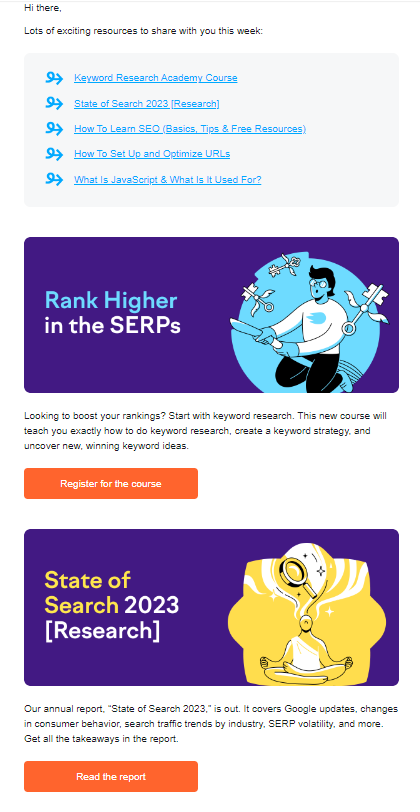
3. Promotional Emails and Offers
Do you want to know what everyone loves? Yes, you got that right—offers, freebies, discounts, loyalty rewards—you name it! Promotional emails have just one goal. And that’s conversions. The idea is to get customers to take action. This could be to purchase at a discounted price, sign up for a limited-time offer, or register for an event.
Promotional email is an excellent type of email to send because it’s a win for both parties. You get to increase sales or user base while the customer gains a gift or discount. The best part about this email is that you can send just about any offer. It could be giveaways or contests, limited-time deals, buy-one-get-one-free (BOGO), seasonal promotions, exclusive deals, free shipping, and more.
If you’re a service-based business or a SAAS provider, you can target other offers such as free trials, valuable bonus content like whitewater or ebooks, membership or training fee discounts, $1 sign-ups, onsite installation discounts, etc.
Here’s an example from Motley Fool, a service-based financial advisor.

The email features important details to keep in mind for a promotional email which are:
- Simple and concise top-page content.
- The value a potential subscriber would gain.
- Colorful elements and text to catch attention.
- A limited time to get the offer—today.
- A clear, visible call to action (CTA).
4. Triggered Emails
Triggered emails, also known as email automation, are types of emails customers receive when they take a specific action. These actions are known as triggers and may include cart abandonment, sign-up, making a purchase, or any action you wish to track.
You can also send out remarketing emails based on behaviors such as email subscribers who:
- Clicked an item or service but never purchased it.
- Opened an email but never clicked.
- Haven’t opened specific emails.
An example of email automation could be a 7-day onboarding email sequence triggered once a user signs up for a specific product.
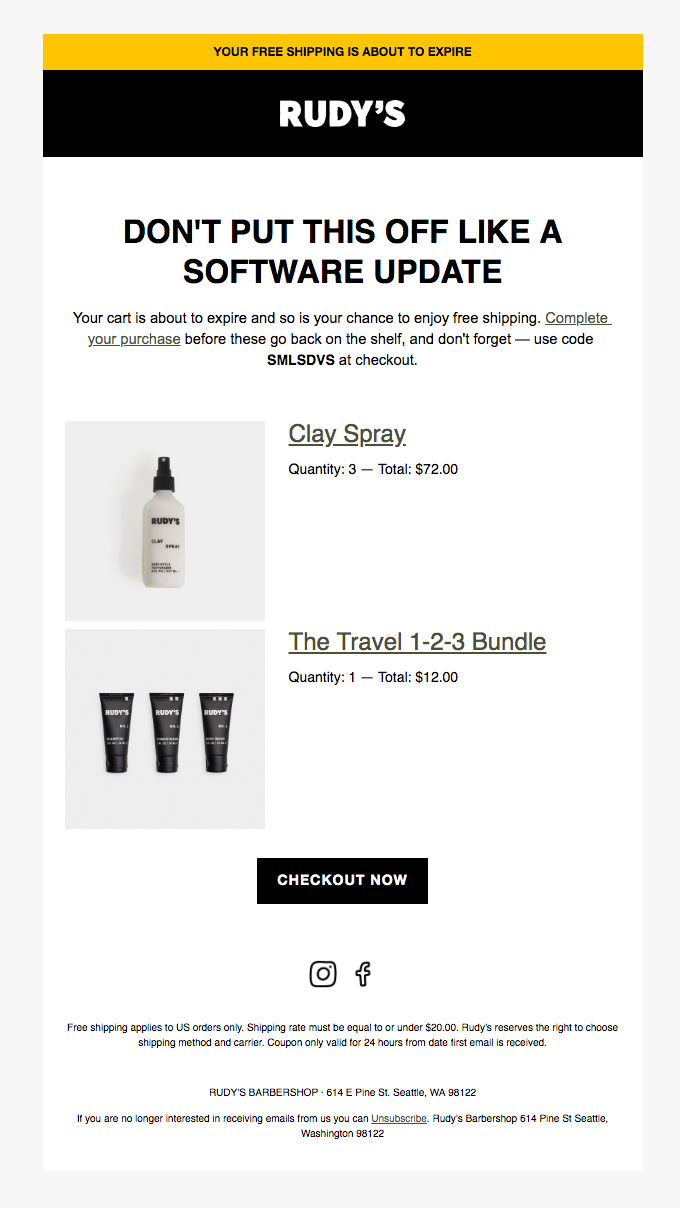
Source: Really Good Emails
Another common one is cart abandonment emails which are sent out when a customer adds an item to their cart but abandons the purchase like in Rudy’s email above.
5. Product Launch Email
Imagine this: you’ve spent tons of resources and hours working on a product. After months and years of hard work, it’s finally time to launch. You’ve not told your customers about this, but that’s not a problem, you think. On that day, you send a one-off lukewarm announcement.
Chances are, many customers would miss or even ignore the release and the product will flop. That’s why well-executed product launch emails are highly important to your success.
If you don’t have a new product coming up, you can send launch emails for upcoming events or sales, feature releases, and pre-order deals.
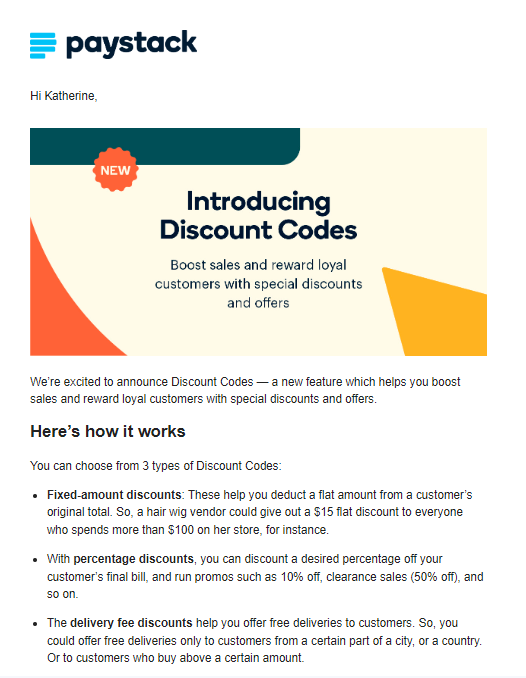
A few things to keep in mind for your product launch email:
- If you don’t have an email list, learn how to build one with this guide.
- Don’t send one-off emails. Ideally, send email sequences starting at least 2 weeks before the launch date and ending a few days after the announcement. For example, your sequence could look like this:
- Pre-launch introduction email to build anticipation a couple of weeks or days before the launch. Hint at what’s coming but don’t give a specific date unless you have one.
- Pre-launch announcement email to reveal the name of the product, a release date, full benefits, value, etc.
- Product launch email to announce the product is ready and accessible. Add share buttons so readers can spread the word.
- Follow-up email sent at least a week afterward to touch base with customers who haven’t tapped in.
- Include helpful resources such as the product’s link, demos, product tutorials, etc.
6. Customer Testimonials Email
Historically, research shows that 95% of shoppers read reviews before they shop. That shows that featuring customer testimonials through emails can help you to convert prospects and drive sales.
Generally, testimonials are often attached to different types of emails such as for product launches. However, you can send it as a standalone email, especially when running a sales campaign. Take a look at how Pulp & Press delivers its customer testimonial emails.
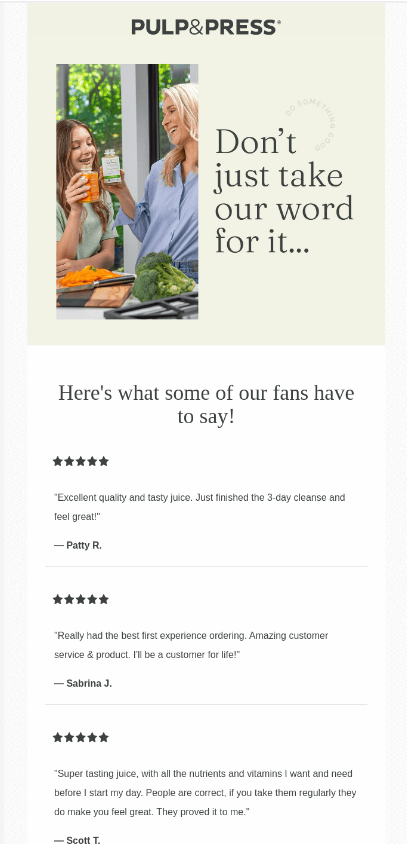
Source: Really Good Emails
Besides text, you can also showcase video-based customer success stories showcasing how your product has made a user’s life better. See how WordPress does this in the email below while offering a product discount.
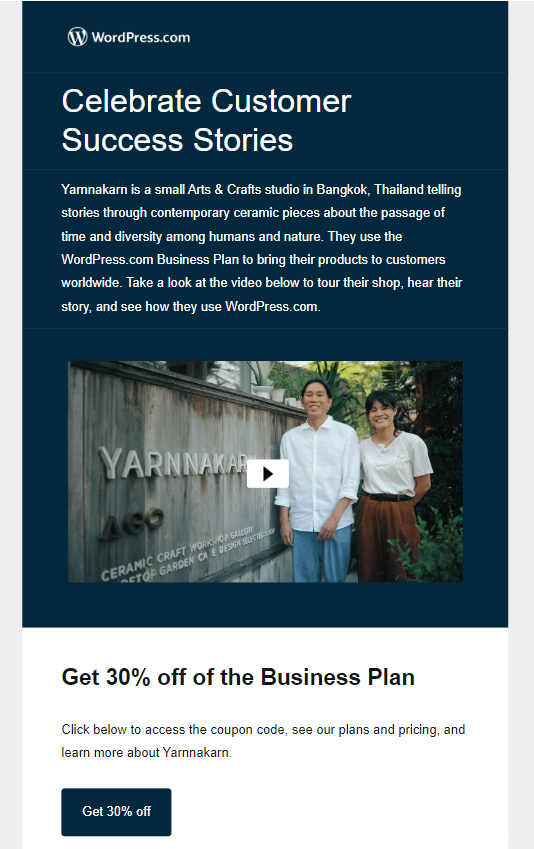
7. Company Updates & Newsletter
Newsletters are a common type of email content businesses send to customers. They allow you to share updates and relevant information about your business or whatever content subscribers signed up for. Sounds boring, right? It doesn’t have to be
The main goal of a newsletter is to help you keep in touch with your subscribers and stay top-of-mind. That means the standard uneventful newsletters won’t cut it. To make this type of email content more engaging, get to know your audience and their interests. And then use that information to personalize your email. This could be by keeping your emails fun and casual when dealing with a young to middle-aged audience.
An example is this newsletter from Trove, a fintech company. They go beyond the standard boring financial newsletters by distilling investment news into bite-sized engaging content. Notice the friendly tone, images and gifs, colorful graphics, and short paragraphs.
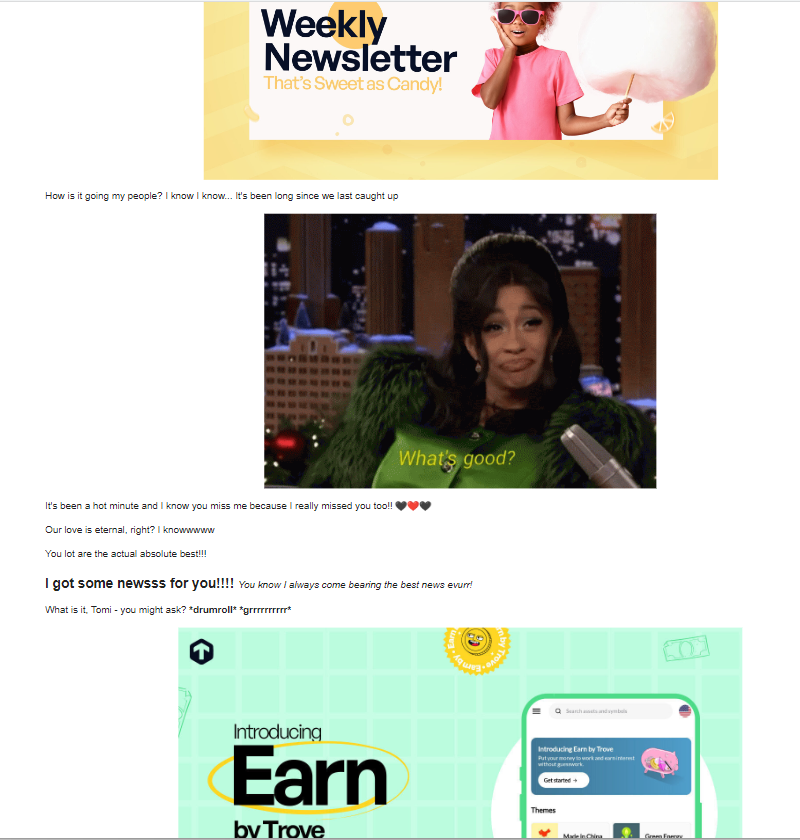
Not sure you can keep it cool and casual with a professional audience? Here’s another newsletter example from Streak. Despite the professional tone, Streak personalized this email by starting with an anecdote about their 4-day workweek experiment. In subsequent sections, subscribers are taken through the story, a brief break highlighting Streak’s new product features, lessons from the experiment, and a link to a detailed blog post.
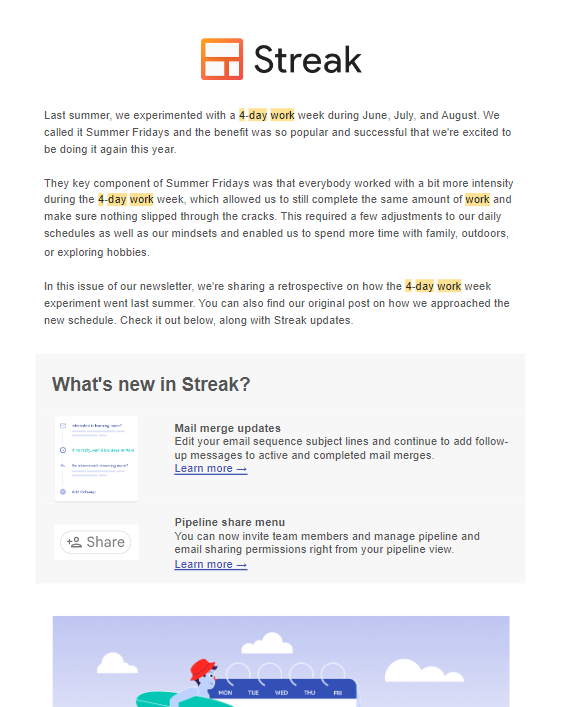
8. Customer Appreciation and Celebration Emails
Did you just reach your first 1000 users? Is today a customer’s birthday? Or did your business just mark its 5th anniversary? Send an email to your customers expressing your gratitude for their support. This shows how much you value them which could help increase customer loyalty.
For B2B companies, service-based businesses, or SAAS, you can focus on milestones. Look out for customers who have either patronized your business a certain number of times, consistently shared feedback, or taken any repeated action.
You can also celebrate usage milestones as Grammarly does in their email below. Notice how they highlight the specific segments a user has excelled in. Chances are that the user would continue to use Grammarly.
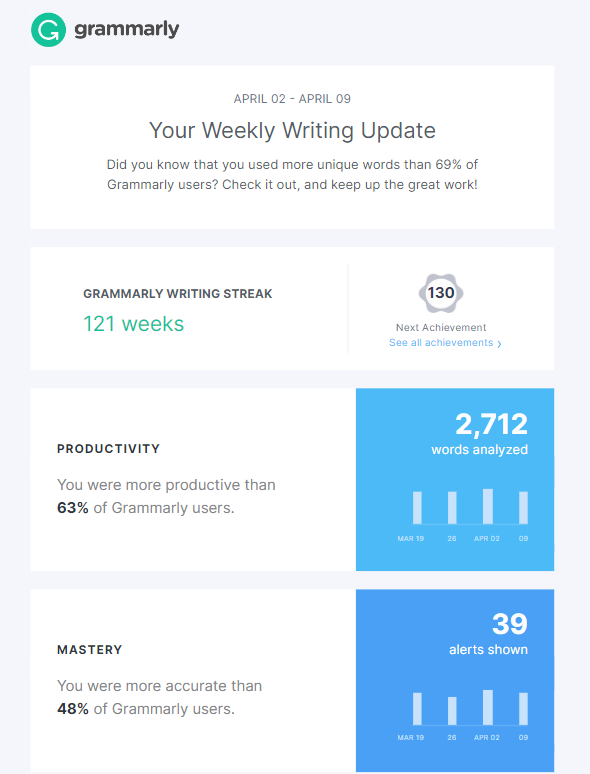
Here’s another example from Loom celebrating my first video recording.
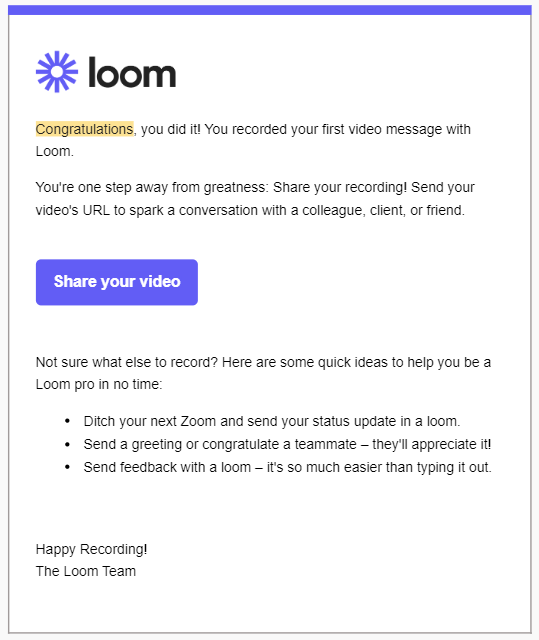
Besides celebrating these wins, you can appreciate customers by sending along a discount, limited-time access to a higher plan, or free shipping/installation.
9. Recruitment Email
Are you hiring? You can let your customers know. They don’t have to apply. But they can refer someone they think would be a good fit for the role.
While this type of email content isn’t the norm, it serves two purposes. For one, it’s a great way to show customers you value their input. Secondly, your customers are likely to have first-hand experience with your product and its value. The combination of this experience and the necessary skills for the job could just give you the star employee you’re looking for.
You could send this email separately or include it in a newsletter like Katelyn Bourgoin, CEO of Customer Camp did in their Why We Buy email below. She mentioned the role at the beginning of the email and then gave more details towards the end.
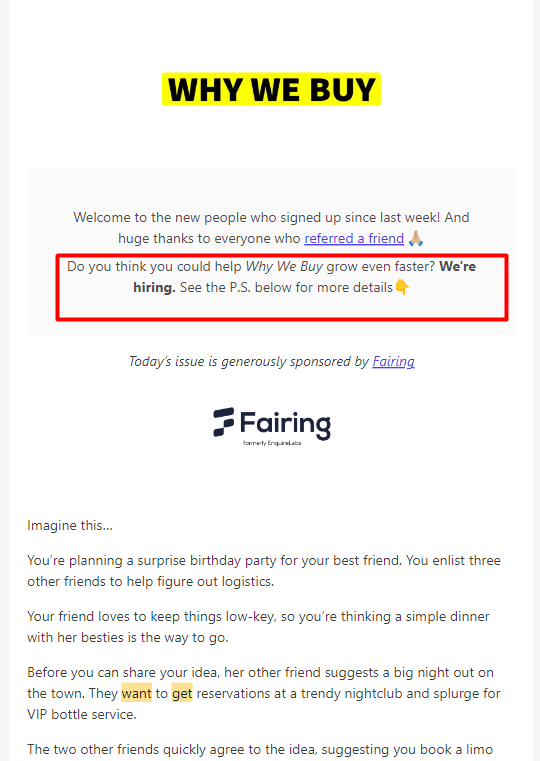
10. Customer Feedback Emails
What better way to learn what you’re doing well (or not) than from your customers? More so, when you ask and act on feedback, your customers feel like their opinions matter. This positive experience could increase customer loyalty and sales.
Customer feedback emails include product or service reviews, customer satisfaction feedback, and an upcoming tool survey like SEMRush’s email below.
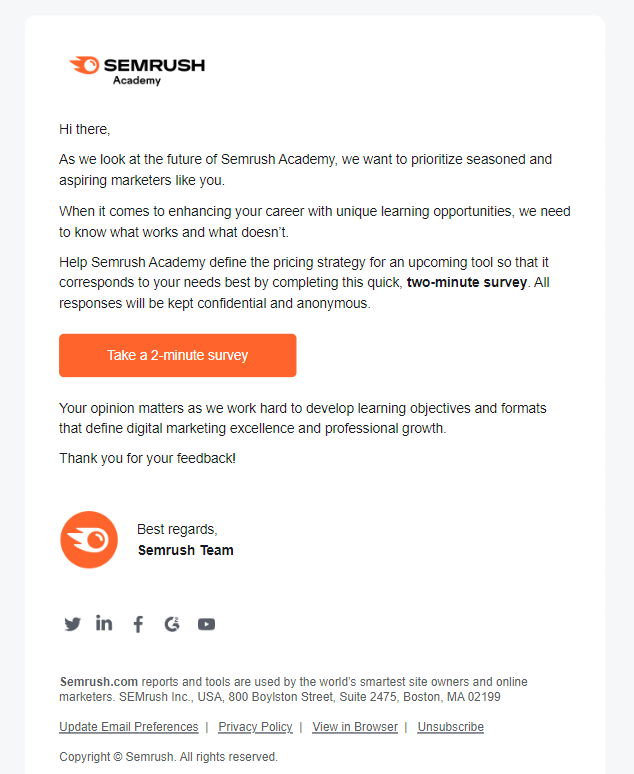
Usually, your customers would be happy to leave feedback once you ask them. However, most of them may not respond. In this case, you can offer rewards to make the process more enjoyable. This offer could be a discount or coupon, gift card, or a specific benefit.
When sending feedback emails, here are a few things to keep in mind:
- Reach out to your loyal and happiest customers first.
- Be upfront about how long the feedback process would take.
- If necessary, offer rewards to encourage reviews. Make sure not to influence them into leaving inauthentic reviews as a prerequisite.
- Be specific about the product or service the customer is reviewing. Ideally, add a link to the review platform.
Get to Work With These Tips!
And that’s it on the different types of emails to send to customers. Don’t stick to boring emails that would make your list go stale. Instead, try out these content ideas for email marketing, track your performance, and find out what works best for your business.
Not sure how to automate your emails or get started with the content? We can help you craft engaging emails, create sequences, and monitor performance. Reach out to us to get started.


